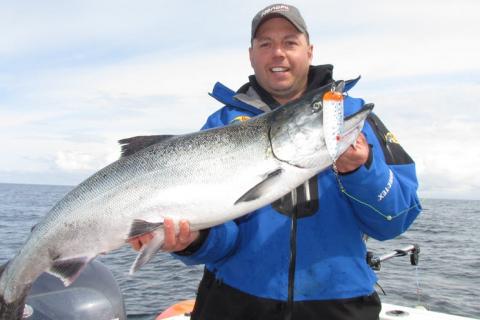
If there’s one species of fish that anglers think about when you mention the northern Pacific Ocean, it has to be Chinook salmon. Salmon are one of the northern Pacific Ocean’s most sought after fish species. They are well known for their long runs, fierce head shakes, and breathtaking leaps and tail-dances  out of the water in an effort to spit the hook. Many salmon battles have caused angler's heart to jump out of their chest. And many of those battles have left an angler cursing with nothing on the end of his or her line but a fishless lure.
out of the water in an effort to spit the hook. Many salmon battles have caused angler's heart to jump out of their chest. And many of those battles have left an angler cursing with nothing on the end of his or her line but a fishless lure.
Salmon Follow the Baitfish
Salmon are forever cruising following baitfish and one of the best ways for anglers to consistently set the hook on salmon is to find the large schools of baitfish the salmon are following. Trolling is the most effective way to catch salmon on the northern Pacific but understanding where to find them and why they’re in the area is the real key to salmon success.
 |
| At the right time of the year, anglers can also catch trophy Coho. |
I believe each time you go fishing and can learn something regardless of the fish species, it can only make you a better angler. When I was fishing with Serengeti Fishing Charters out of Port Hardy, British Columbia, Canada, several years ago, we located schools of baitfish on our fish finder in depth of 20 to 72-feet of water only 150 to 300-feet off the edge of a forgotten island. The heavy smashing waves were beating schools of baitfish against the rocks. The punishment of being slammed against the rocks dazes and wounds the baitfish and as the baitfish struggled to get away from the dangers of the rocks and the pressure of the waves, salmon patrol the first drop-off into the deep water straight out from the rocks.
 |
| Mooching rod & reel set to 55-feet with a Scotty downrigger. |
As the baitfish moved into the deeper water and what they thought was safety from the rocks, feeding salmon were there waiting for an easy meal. The proverbial. “Stuck between a rock and a hard place”.
Anglers can play into the feeding salmon by trolling baited hooks, crankbaits, or trolling spoons, at the first drop-off into the deeper water. This is one of my favorite ways to catch salmon and if the timing is right, anglers can also set the hook on a few Coho.
A Typical Day of Troll Fishing for Salmon
 |
| Okuma RAW-1002 Center Pin Float Reel |
We began trolling 100-yards off a rocky shoreline that surrounded the small island. Waves crashed against the rocks as we set up our 11-foot G Loomis SAR 1265C Mooching rods combined with an Okuma Center Pin reel.
We positioned the boat and trolled in 50 to 70-feet of water straight out from the rocks. The area we were covering was roughly the length and width of a football field. The bait on this particular day was a Len Thompson number 16-Dimpled Series spoon in the Gray Ghost pattern sent down to the targeted depth of 50 to 55-feet of water by the Scotty downriggers targeting the suspended salmon that were patrolling the deeper water actively feeding on fleeing baitfish. We trolled three rods out the back of the boat spooled with 20-pound Bass Pro Shops XPS Hyper Braid fishing line and it didn’t take long for the first salmon to trigger a rod.
Salmon are well known for their never give up attitude. Because of their aggressive fighting nature, an angler must keep a tight line during the fight or the fish will spit the hook. This is especially true if you are using the aid of a flasher.
 |
| G.Loomis E6X Salmon Mooching Casting Rod |
As you reel in your salmon and the flasher which is usually five to eight feet in front of your presentation brakes the surface of the water and is free of the resistance of the water, it’s not uncommon for it to create slack in your line. Even if it’s only for a split second, it’s enough time and slackline for the salmon to free itself especially when you’re using barbless hooks which is common when fishing salmon waters.
 |
| The birds and killer whales knew the importance of fishing the windswept rocks of the Pacific Ocean and so should salmon anglers. |
Finding Where the Chinook Salmon Are
Trolling and imitating wounded baitfish along the rocky shorelines is my preferred technique to catch Chinook salmon in freshwater or saltwater on the west coast. However, not all shorelines are created equal. Years ago, an experienced salmon angler once told me a quick way to find active shoreline is to watch the birds. Birds also feed along the rocky shoreline and islands on the dazed and wounded baitfish. And once you find feeding birds you’re sure to find salmon. It’s also not uncommon to see a pod of killer whales patrolled the same area feeding on the same salmon you're trying to catch. On several of my outings, it wasn’t uncommon for killer whales to surface only 40-yards from the boat.
![]() Tip: The birds and killer whales instinctively know the importance of fishing the windswept rocks of the Pacific Ocean and so should salmon anglers.
Tip: The birds and killer whales instinctively know the importance of fishing the windswept rocks of the Pacific Ocean and so should salmon anglers.
Watch video: Wes David host of Fishing the Wild West is fishing for salmon
- 17175 views

